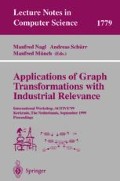Abstract
We discuss an intermediate language to represent transitions defining behaviours of autonomous agents. The language allows a uniform representation of several diagrammatic languages for specification of reactive systems, based on an underlying notion of transition. The translation of graph transformations to this language opens an opportunity for a notion of communication between agents represented by graphs.
Partially supported by the EC under TMR Network GETGRATS and Esprit Working Group APPLIGRAPH. P. Bottom is with the Pictorial Computing Laboratory
Access this chapter
Tax calculation will be finalised at checkout
Purchases are for personal use only
Preview
Unable to display preview. Download preview PDF.
References
G. Agha, Actors: A Model of Concurrent Computation in Distributed Systems, MIT Press, 1986.
J.M. Andreoli, R. Pareschi, “Linear objects: Logical processes with built-in inheritance”, New Generation Computing, vol.9, n.3–4, 445–473, 1991.
J.P. Banatre, D. LeMetayer, “The Gamma Model and its Discipline of Programming”, Science of Computing Programming, vol.115, 55–77, 1990.
W. R. van Biljon, “Extending Petri nets for specifying man-machine dialogues”, International Journal of Man-Machine Studies, vol.28, 437–455, 1988.
U.M. Borghoff, P. Bottoni, P. Mussio, R. Pareschi, “Reflective Agents for Adaptive Workflows”, Proc. PAAM’ 97, 1997, 405–420.
P. Bottoni, P. Mussio, B. Olivieri, M. Protti, “A completely visual environment for agent-based computing”, Proc. AVI’98, T. Catarci, M.F. Costabile, G. Santucci, L. Tarantino eds., ACM Press, 1998, 261–263.
N. Carriero, D. Gelernter, How To Write Parallel Programs. A First Course, MIT Press, 1990.
A. Corradini, F. Rossi, “Synchronized Composition of Graph Grammar Productions”, in H. Ehrig, G. Engels, G. Rozenberg eds. Graph Grammars and Their Application to Computer Science, Springer, 1995 [9], 257–270.
J. Cuny, H. Ehrig, G. Engels, G. Rozenberg eds. Graph Grammars and Their Application to Computer Science, Springer, 1995.
J. Engelfriet, G. Rozenberg, “Node Replacement Graph Grammars”, in [18], 1–94.
A. Corradini, U. Montanari, F. Rossi, H. Ehrig, R. Heckel, M. Lowe, “Algebraic Approaches to Graph Transformation-Part I: Basic Concepts and Double Pushout Approach”, in [18], 163–245.
H. Ehrig, R. Heckel, M. Lowe, L. Ribeiro, A. Wagner, A. Corradini, “Algebraic Approaches to Graph Transformation-Part II: Single Pushout Approach and Comparison with Double Pushout Approach”, in [18], 247–312.
I. Fischer, M. Koch, G. Taentzer, “Local Views on Distributed Systems and their Communication”, in Proc. TAGT98, G. Engels, G. Rozenberg eds., Universitat Paderborn tr-ri-98-201, 1998, 40–47.
M.R. Genesereth, S.P. Ketchpel, “Software Agents”, Communications of the ACM, vol.37, n.7, 48–53, 1994.
D. Janssens, G. Rozenberg, “Actor Grammars”, Mathematical Systems Theory, vol.22, 75–107, 1989.
J. Meseguer, “A Logical Theory of Concurrent Objects and its Realization in the Maude Language”, in Research Directions in Concurrent Object-Oriented Programming, G. Agha, P. Wegner, A. Yonezawa eds., MIT Press, 1993, 314–390.
F. Parisi Presicce, “Transformations of Graph Grammars”, in H. Ehrig, G. Engels, G. Rozenberg eds. Graph Grammars and Their Application to Computer Science, Springer, 1995 [9], 428–442.
G. Rozenberg ed., Handbook of Graph Grammars and Computing by Graph Transformation, Vol. 1, World Scientific, 1997.
G. Taentzer, “Hierarchically Distributed Graph Transformation”, in H. Ehrig, G. Engels, G. Rozenberg eds. Graph Grammars and Their Application to Computer Science, Springer, 1995 [9], 304–320.
Author information
Authors and Affiliations
Editor information
Editors and Affiliations
Rights and permissions
Copyright information
© 2000 Springer-Verlag Berlin Heidelberg
About this paper
Cite this paper
Bottoni, P., Parisi-Presicce, F., Simeoni, M. (2000). On a Uniform Representation of Transformation Systems. In: Nagl, M., Schürr, A., Münch, M. (eds) Applications of Graph Transformations with Industrial Relevance. AGTIVE 1999. Lecture Notes in Computer Science, vol 1779. Springer, Berlin, Heidelberg. https://doi.org/10.1007/3-540-45104-8_5
Download citation
DOI: https://doi.org/10.1007/3-540-45104-8_5
Published:
Publisher Name: Springer, Berlin, Heidelberg
Print ISBN: 978-3-540-67658-4
Online ISBN: 978-3-540-45104-4
eBook Packages: Springer Book Archive

